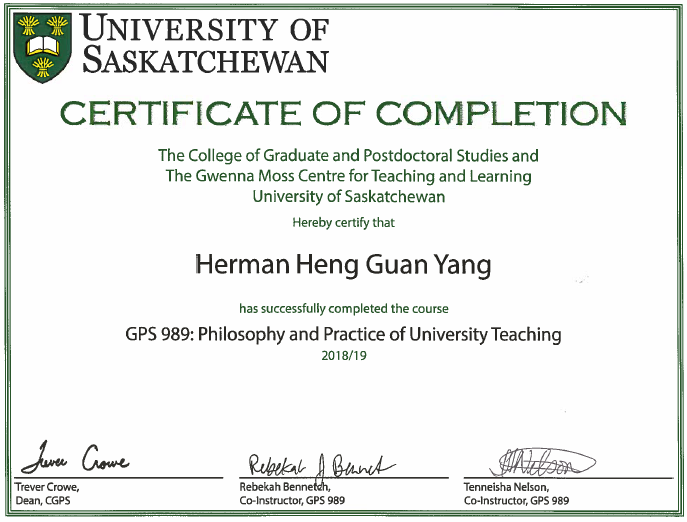GPS 989: Philosophy & Practice of University Teaching
Issuer: Gwenna Moss Centre for Teaching and Learning, University of Saskatchewan

This is a full-year course relating to teaching at the university level. Although the course name is "University Teaching", the course learning outcomes can also be applied in non-academic settings (e.g. coaching or business presentation).
The course covers various topics related to communication skills, such as three modes of persuasion (Ethos, Pathos, and Logos), five teaching perspective inventory, four main learning preferences, various teaching methods, and types of academic assessment. Some practical role-play discussions are also included such as handling students with learning disabilities, diverse backgrounds, or aggressive behaviours.
Design for Disability
It extremely inspiring to learn from this course about the concept "design for disability, not for norms" which is an idea presented in a TEDx Talk by Elise Roy. This is perhaps my biggest takeaway from this professional course since it is my goal to create an inclusive environment in classroom settings, events, and my community.
Teaching students with disabilities can be a huge challenge for many educators. If there is a disabled person in our classroom, we can't avoid redesigning our teaching strategies and lesson plans to accommodate persons with disabilities. While people often think disabled students are a burden for educators, this course has changed my views on disabilities as I have learned that designing for disability does not just benefit disabled persons, but everyone!
Think about an automated door with a button designed for people with movement disabilities. Is that common for many people other than disabled people to use such a button? Yes, because it also benefits those who want to pass through the door while carrying a lot in their hands. Think about the subtitles in movies and videos. Even if I watch a movie in my own native language, subtitles in my native language help me significantly in understanding the movie. All these designs which seem to only benefit "disabled persons" at the end also benefit everyone in general. We can also apply this simple concept in the teaching environment.
So how can we design for disability in teaching environments? Some examples include practicing a slower speaking pace, repeating key notes, finding a balance between written and oral instructions, using body languages, and many more. This will not just help students with learning disabilities. Even high-performance students would appreciate educators to deliver lessons that are more inclusive too, wouldn't they?
Microteaching
This course provides two microteaching experiences where one gives a 5-min presentation to a general audience and receives peer evaluations. As I value feedback and peer-review processes, these experiences are excellent platforms for me to exercise continuous improvement on teaching based on constructive criticism. From the feedback I received, I examined repeating patterns of specific comments on strengths as well as on areas of improvements. This allowed me to continue utilizing my strengths and take necessary actions to address the identified weaknesses. Below is some feedback from both microteaching experiences.